Notes for MASS Zoom Meeting on November 13, 2020
We had great participation. Dean, Keith, Silvio, Phil, Hank, Jim Plaxco, Harry and I were all on the zoom meeting for 2 1/2 hours. This was our 69th meeting and the 5th one using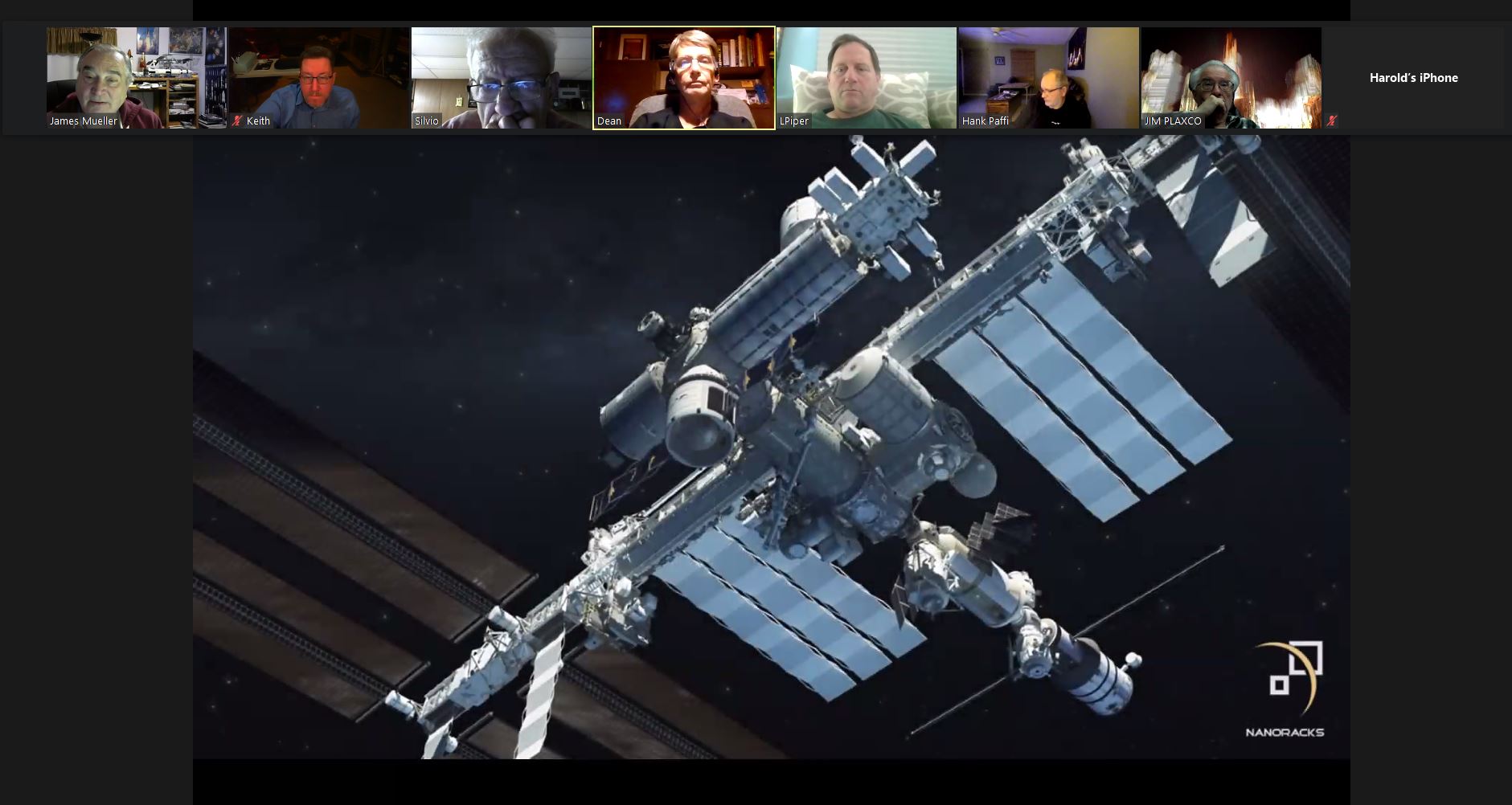 Zoom. I’m still waiting for the time we can all participate in person. Nothing beats the give-and-take of an in-person get together. We all gave Beth a pass on missing this meeting because she is on side of a volcano in Hawaii participating in a 2 1/2 week Mars simulation. We all can’t wait to hear how that went.
Zoom. I’m still waiting for the time we can all participate in person. Nothing beats the give-and-take of an in-person get together. We all gave Beth a pass on missing this meeting because she is on side of a volcano in Hawaii participating in a 2 1/2 week Mars simulation. We all can’t wait to hear how that went.

At meeting start, I quickly covered a few miscellaneous items. First I commented on the first episode of a new 6-part comedy series called “Moonbase 8″ on ShowTime with John C. Reilly and Fred Armisen. I found it humorous but online reviews haven’t been too kind. It deals with some older astronaut candidates going through a moon simulation exercise in the desert on Earth.
Next I brought up the idea of a new MASS Prize contest. I suggested that we try to guess how many people will go into space in 2021. For the definition of space, we’ll use the Air Force height of 50 miles (80 km). This way we can include anyone that flies on the sub-orbital missions from Virgin Galactic and Blue Origin. We’ll also be counting the astronauts launching from Russia and the US (SpaceX Dragon, Boeing Starliner or NASA Orion capsule) and any others from China or India. The prize will be a $20 gift certificate to Dairy Queen or Starbucks. Ties will share the prize. Guesses must be made before December 2, 2020.
Halloween marked the 1 year mark until the launch of the James Webb Space Telescope. There was an audible “hurray” within the zoom meeting. Let’s hope they stick to the 10/31/2021 scheduled launch date.
Lastly, I mentioned that on December 21, Jupiter and Saturn will be at their closest conjunction in over 400 years. The two planets will be only 7 arc minutes (1/4 the diameter of the moon) distance apart. It will be quite a sight through a telescope and a good test for the naked eye observers (clarification, “naked eye” means to observe without optical aids, I’m not encouraging anyone to stare at the sky without any clothes on.). On December 6, we will see the landing of the capsule from the Japanese spacecraft, Hayabusa 2, with its sample of the asteroid Ryugu in Australia. Japan and the US will share samples from each others asteroids. The US will contribute a percentage of their Bennu sample.

Topic number one was the SpaceX CREW1 mission launching 4 astronauts to the ISS at 6:27 PM CST on Sunday night, November 15. This is the first operational crew launch where the Dragon capsule and crew will spend about 6 months on the Space Station. The Commercial Crew program goes back all the way to 2010 but the down-selection to two companies occurred in July 2013. The contract was for Boeing to get $4.2 billion and SpaceX $2.6 billion to develop their capsules. NASA originally thought SpaceX would be a “long shot” and Boeing would be the “sure thing” to develop the capability. It turns out that Boeing is the one with problems. They are at least a year behind SpaceX. Their re-try of a unmanned test, OFT-2, has now slipped to the first quarter of 2021 and the first test manned mission with Starliner might not be until August 31, 2021. Boeing is also going to charge NASA $90 million for each seat on Starliner, that is about the same as Russia was charging for a seat on Soyuz. SpaceX is a much better deal because they will charge only $55 million. Quite a difference in price.
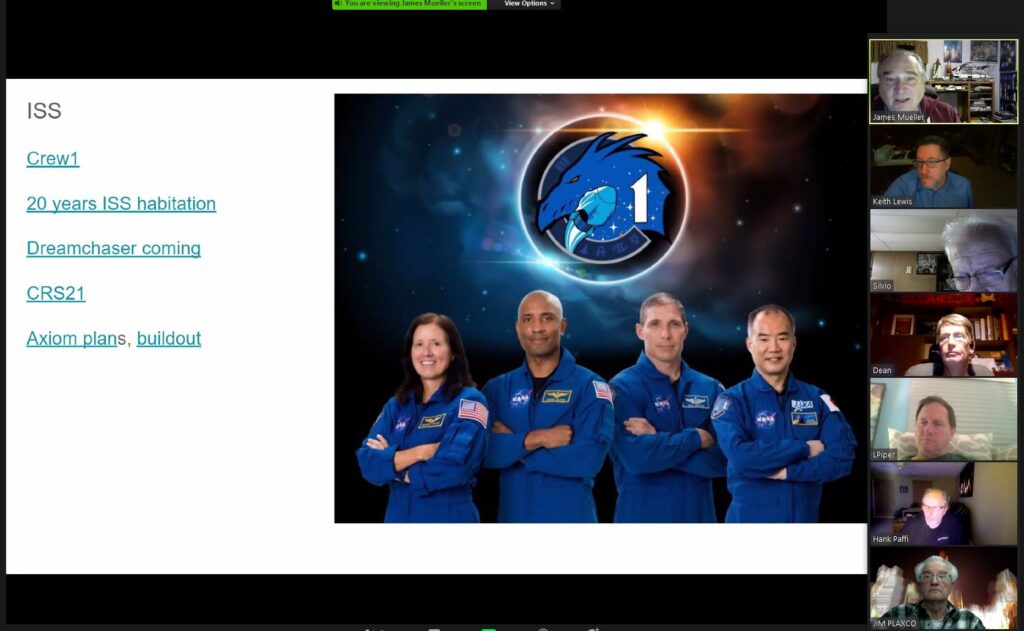
The recent CREW1 mission delay from October to mid-November was due to an over-pressure issue with the gas-generators on the Falcon 9 Merlin engines. SpaceX found the issue on the scrub of the GPS-III SV-04 launch attempt on October 2 at T-2 seconds. The newest Merlin engines had a lacquer applied while a part was being anodized by a 3rd-party vendor and the lacquer was not completely removed after the process causing blockage of a relief valve. NASA and SpaceX quickly troubleshot the issue, replaced two engines on the GPS-III SV-04 rocket and successfully launched it on November 10. Two engines were also replaced on the CREW1 rocket and SpaceX successfully test fired its engines the week before launch. Another 1 day delay was caused by the last hurricane to blow by Florida into the Atlantic. The barge that SpaceX uses to land its first stage could not make it to the landing zone in time because of the rough waves. So the launch was delayed from Saturday to Sunday. The rocket is very important to NASA because it will be reused for the CREW2 mission in March of 2021. I was a little disappointed that when the launch slipped a day, the time it takes Dragon to reach the ISS increased from 8 hours to 27 hours. This is due to “phasing” which is a measure of the location of the ISS in its orbit when the plane of space station orbit passes over Florida. The longer docking time is due to Dragon having to take a longer path around the earth as it chases down the ISS.
Since the meeting, the CREW1 mission launched successfully on its first try at 6:27 PM Sunday, November 15, 2020. Congratulations to NASA and SpaceX in a launch without any issues. A baby yoda was the “zero-G” indicator for this crew. It looks like this crew of 3 veterans and 1 rookie will have a good time on their 6 month stay on ISS.
The Dragon capsule for CREW1 has had a couple of design tweaks since the DM2 mission. It was noticed that the heat shield had slightly more ablation in a few spots, so it was beefed up in those areas and the initial drogue chutes deployed at little lower height than anticipated, so SpaceX changed the instrument that senses the altitude of Dragon. Both issues were well within the safety margin but incremental improvement is desired. Also on the return of CREW1, the Coast Guard will strictly enforce the 10 mile exclusion zone. Hopefully, we won’t see any pleasure boats zooming around the bobbing capsule this time.
The 4 astronauts from CREW1 will join the crew of 3 already on ISS, 2 Russians and NASA’s Kate Rubins. This will mark the first time that the US segment will have a crew of 5 for 6 months. Having an extra person or two will more than double the science that can be accomplished. The Dragon capsule for CREW1 will set the record for the longest time spent in space by a US vehicle (180 days will be the nominal mission). The longest previous mission was the Apollo capsule on SkyLab 4, with 84 days on orbit. The longest Apollo moon capsule is Apollo 17 at 12 days, the longest manned Dragon capsule is 64 days on DM2. The longest time in space for the Space Shuttle is 17.7 days. The longest a Russian Soyuz capsule has been in space is the TMA-9 mission, at 215 days. The Soyuz is limited by the break down of hydrogen peroxide used in its thrusters. Dragon capsules are limited by the degradation of its solar panels by mono-atomic oxygen in the upper atmosphere. The CREW1 Dragon is certified for 210 days in space.
One thing that I’m not too excited about the CREW1 mission, is that Mike Hopkins is scheduled to be inducted into the new Space Force. I just feel this is bringing the military into what should be a civilian program. I’m sure this is another vestige of the current administration’s “show-boating”. I hope they don’t overly publicized it.
A successful CREW1 mission should end the US having to pay Russia for seats on Soyuz. The US has paid Russia about $4 billion for 71 Soyuz seats since 2006. NASA’s plan is for Russians to fly on Dragon or Starliner and US astronauts to still fly on Soyuz under a “trade” agreement. For some reason the Russians have still not agreed to do this. The next Soyuz is scheduled to launch 3 Russians on April 10, 2021.
On November 2, 2020 the ISS celebrated 20 years of continuous habitation. It is amazing that we’ve been able to accomplish this and we couldn’t have done it without the Russians. When the Columbia Space Shuttle was lost, the Shuttle program was grounded for 2 1/2 years and when we retired Shuttle, the Soyuz was the only way for astronauts to get into space for 9 years. I’ve got to hand it to the Russians on their ability to “stay the course.” I listened to a podcast by Bill Shepard, the US astronaut on the initial crew of ISS. He talked about the early years of space station design. The US went through at least 6 re-designs of Space Station Freedom starting in the Reagan years and blew through $11 billion without ever flying a pound of hardware. When we finally decided to partner with the Russians, the station design was stripped down in complexity. 5 of the 6 US industrial vendors were cut out of the program and there would be much fewer international astronauts launched to the space station. Many factions were not happy with the new plan.
Bill Shepard compared the Russian mind set to the US perspective about building a space station. The US is like a custom builder that digs a foundation, pours the concrete, starts putting up wall studs, runs the electrical and plumbing, etc. The Russians are like someone who creates a driveway, drives a Winnebago onto it and then opens the door. The Russians were very wary at first that the Americans were trying to steal their prowess in maintaining space stations. The Russians had 6 space stations in orbit since our SkyLab was deorbited. Mir was the last one. The US gained invaluable experience docking the Shuttle to Mir and sending astronauts there. Negotiations have been strained at times through the years, but I feel the international flavor of the ISS is a great accomplishment. Great projects sometimes require the resources and viewpoints of many to be successful.
With arrival of the CREW1 Dragon, the ISS has had 227 vehicle visits with 101 of them manned. There had been 432 astronaut visits by 242 different people from 19 countries. The vehicle dockings include, 37 shuttles, 64 Soyuz, 73 Progress (cargo variant of Soyuz), 5 ATVs supply craft from Europe, 2 Proton launches by the Russians, 9 HTVs supply craft from Japan, 20 cargo Dragons, 3 crew Dragons (1 unmanned) and 14 Cygnus supply capsules from Northrup Grumman. As of November 1st, there have been 13,749 habitation days by American astronauts, 13,981 days by Russian cosmonauts and 4419 days by astronauts from other countries. Long duration Expedition crews (6 month missions) have included 83 Russians, 80 Americans, 15 from the European Space Agency, 2 Canadians, and 9 Japanese. Now you know how I spend much of my time, doing space stats.
The ISS should be able to last until 2030. The Russian segment, Zvezda, is showing its age a bit. It has sprung an air leak through a fatigue crack in the hull. It isn’t a big concern but the station is losing about .02 psi every 8 hours. The Russians feel they will be able to fix it. NASA has plans to fund ISS through 2024 but they hope to pass it off to a commercial venture by 2025. The money NASA frees up will help fund the Artemis effort to return to the moon. I’m not sure a commercial entity will be ready that quickly and I hope the new administration will fund ISS at least until 2028. That seems a more reasonable plan to keep a manned presence in Low Earth Orbit (LEO).
I’m excited about the coming year, a new ISS supply vehicle, the Dream Chaser will be joining the Dragon and Cygnus supply craft. I’ve always liked the Dream Chaser because after its supply mission it can land at an airport with cargo from space. It does not use any toxic fuel so any airport that can land a 737 would be suitable. Unloading the time critical materials will go much quicker from a runway than from a capsule bobbing in the ocean. The craft has the Shooting Star service module in the back that can hold additional cargo. Dream Chaser will be certified for 15 missions and should begin supplying the ISS in late 2021. It will launch on the new Vulcan rocket from ULA. Steve Linsey, who is a senior vice president at Sierra Nevada, has flown on the Space Shuttle 5 times. The first Dream Chaser is named Tenacity and can carry 11,000 lbs of cargo to ISS. During the second round of Commercial Cargo from NASA, each of the 3 vendors will be assured 6 missions. Northrop Grumman just announced that NASA is contracting them for 2 additional missions. Sierra Nevada hopes to eventually develop Dream Chaser into a manned vehicle that could carry a crew of up to 5. They are targeting the cost of a person flying Dream Chaser to be the same cost as Crew Dragon, $55 million per person. Maybe the day will come when we should “cut bait” with Starliner from Boeing and push for manned missions with Dream Chaser. Sierra Nevada is also working on inflatable habitats (short animated picture in the URL). Their technology is different than Bigelow Aerospace, but the two companies have also worked together. Sierra Nevada is also partnering with Dynetics on the Alpaca lunar lander proposed under the Human Landing System (HLS) which is part of Artemis.
The latest cargo supply mission from SpaceX, CRS21, is scheduled for December 2020. It will be the first to use the new Dragon 2 capsule for cargo. The capsule will be a reuse of the DM-2 capsule that brought Bob and Doug to ISS in May. It will carry the new Bishop commercial airlock (check out the “Nanoracks Bishop Airlock Module” 5 min video on the URL, pretty cool animation of what Bishop can do.) in its “trunk”. The air lock is very versatile. One of its main functions is to deploy cubesats. It increases the ISS capability by a factor of 5 in launching cubesats. CRS21 will compete with crewed Dragons and Starliner capsules for an International Docking Adaptor (IDA) port. The ISS only has 2 IDA compatible docking ports. When the Starliner capsule in the OFT-2 test launches for its 8 day mission in the 1st quarter of 2021, CRS21 will have to be gone. NASA plans to relocate the CREW1 Dragon to the zenith IDA port of the Harmony module so that Starliner has a simpler docking procedure to the leading IDA port on Harmony. The CRS21 mission starts SpaceX’s second round of cargo missions. The first round of supply, COTS1, had 20 missions from SpaceX and 11 from Northrop Grumman. During COTS1, SpaceX brought over 95,000 lbs (43 mt) of supplies to the ISS and brought down 75,000 lbs (34 mt) of science results and equipment. Northrop brought up over 66,000 lbs of supplies. COTS2 will include 6 more missions from each the Dragon 2 from SpaceX, Cygnus from Northrop Grumman (just increased by 2 to 8 missions) and the Dream Chaser from Sierra Nevada. Northrop Grumman has already launched 3 Cygnus capsules under COTS2.
The future of the ISS might be to hand LEO space off to a commercial venture. Axiom Aerospace seems to be the primary entity that would allow this to happen. Their first efforts are to fly commercial astronauts to the ISS at a rate of 2 per year. First flight will occur in the 4th quarter of 2021 with a 10-day flight on a Dragon capsule and includes Michael Lopez-Alegria, an experienced NASA astronaut now with Axiom, and 3 others. Conjecture is that it will be Tom Cruise, his film director and another person will complete the crew. These astronaut flights are a precursor to Axiom flying their own modules starting in 2024 up to the ISS before the ISS reaches its end of life in 2028-2030. Using the ISS to start their modules will help them form their own free-floating commercial space station after the ISS is retired (nice 2 minute video of the build and detach plan). I feel we have to show how we can transition to the Axiom space station without having a decade long gap in LEO before the United States starts the next great thing. The Chinese are looking to take advantage of our potential downtime by starting their own space station around the ISS retirement date. What a disappointment if we build the infrastructure only to have the Chinese benefit from it. NASA says we can operate ISS until 2028 or 2030 but the White House (WH) is trying to transition by 2025 which seems a little too quickly. The current administration wants to shut down ISS support and shift the money to Artemis.
Should Bridenstine stay as the NASA administrator under a Biden White House? This was a popular topic for the MASS crowd. The consensus was that he is an asset to NASA and should be retained. He is a savvy politician and his Artemis accords and partnering Gateway with ESA is cementing the future of the US space program. Changing course could tick off our partners. He is also getting commercial providers in Artemis and not throwing everything to SLS and Boeing. Unfortunately, he says he’ll step down with the quote that “We’ve had a lot of success, but it’s because of relationships”. The NASA director continued, “You have to have those relationships. Whoever the president is, they have to have somebody they know and trust and somebody the administration trusts. That person is not going to be me.” He seems to have closed the door rather sharply on any possibility of staying on the job.
Trying to devine Biden’s space plans, Casey Drier & Jeff Foust, a senior writer on Space News on the Planetary Society, did a deep hour long podcast on their opinions. Trump wants to up NASA budget by 12% and fund Artemis for the back to the moon by 2024. Biden has no formal space policy document. Most people feel he will stay the course but not embrace the 2024 moon landing deadline. Neither Biden or Harris have shown any personal interest in space. I feel the country at the moment is more concerned about much bigger issues than space. Issues like the pandemic and getting the economy going again. Some people make the point that Biden was close to NASA when he was vice president. Like Lyndon Johnson, who was vice president before becoming president, this could be a positive. I personally don’t see Kamala Harris getting too involved with NASA. Biden announced his 8-person NASA transition team led by Ellen Stofan (current head of Smithsonian’s Air and Space Museum). Stofan was NASA’s chief scientist from 2013 to 2016. Others on the team include, Jedidah Isler, an astrophysicist, Pan Melroy, former astronaut and Waleed Abdalati, another NASA chief scientist 2011-2012 who’s currently at University of Colorado. Many feel Biden will re-prioritize climate research, extend funding for ISS, keep Artemis going but not with a manned landing by 2024 . His date for an Artemis moon landing will probably 2028, whcih is more reasonable and better aligns with the House Science Committee bill. Lori Garver, a former Deputy Administrator at NASA, also feels he will encourage commercial space.
The “Green Run Test” of the initial core stage of SLS has been delayed again until early 2021. The subsequent trip of the core stage to Kennedy Space Center is still slated to occur in mid Jan 2021. The first launch of SLS, Artemis 1, is still scheduled for November 2021. I’m curious if SLS continues to be delayed, and if SpaceX gets its new super heavy rocket, StarShip, flying, will SLS become irrelevant? Elon Musk has said that he can launch the fully reusable StarShip for $2 million, the cost of the fuel. The SLS is currently costing up to $2 billion for each rocket. That is a factor of 1000 in cost for comparable capability.
NASA announced the signing of the Artemis Accords by Australia, Canada, Italy, Japan, Luxemburg, UAE, UK and US. The full 7 page document is available here. The pact will help to avoid conflict between nations by providing transparency in their plans. It applies to the Moon, Mars, the Langrangian points, comets and asteroids. Japan wanted to include the last 2 types of astronomical bodies. The accords deal with intellectual property and states that space activities are for peaceful purposes. It commits members to transparency in their activities and says that there should be a broad dissemination of information and sharing of scientific information. It helps ensure interoperability of systems and commits all parties to make reasonable efforts to render assistance to personnel in space. Signees have to register space objects, preserve space heritage, make use of space resources in compliance with the Outer Space Treaty and inform Secretary-General of UN on resource extraction, refrain from activity which causes harmful interference with others, provide notification of activities and commit to coordinating in order to avoid harmful interference. It sets up the creation of safety zones by nations, but these areas are not exclusion zones. It also references the mitigation of orbital debris. We all agreed with the principles of the accords but wondered where the teeth of enforcement would come from.
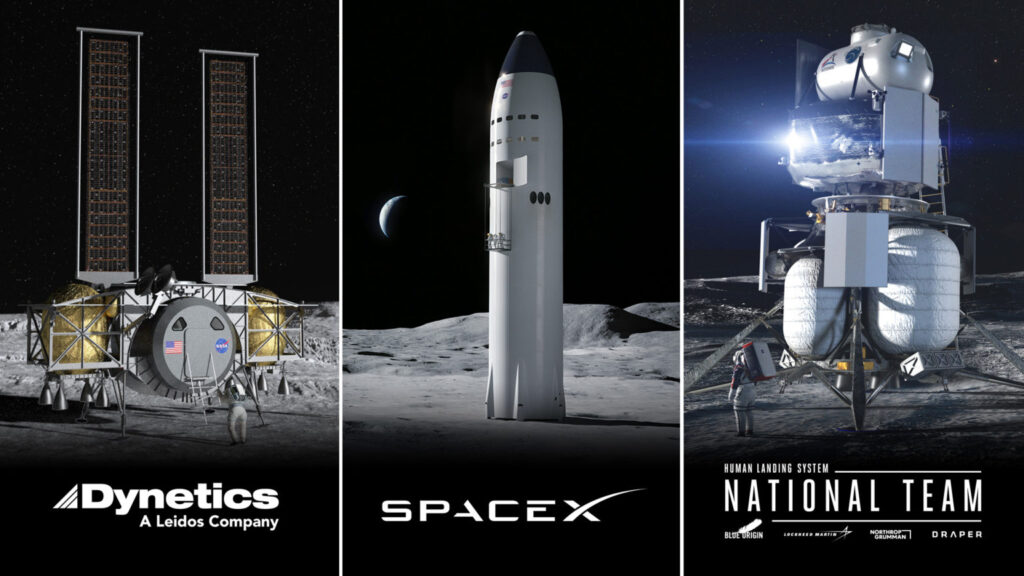
New Human Landing Systems (HLS) for Artemis – Alpaca, Starship or Blue Moon? Starship is completely reusable and delivers the heaviest payload but it looks very cumbersome to get to surface and the steel skin for atmospheric flight is a big weight overhead, Blue Moon has an enormous ladder and 2/3 of it is not reusable. It might be overly complex with a tug to move it in orbit, a lander, and an ascent module. Alpaca seems most streamlined for the mission, has the easiest access to surface for astronauts and only the two outside fuel tanks are discarded. The Senate is proposing $1 billion in FY 2021 funding, which is $2.4 billion short of the WH request. The full NASA budget would get $23.5 billion in FY 2021 an increase over last year, but $1.75 billion less than the WH requested. The 3 HLS landers got only $628 million from the House proposal. The most probable outcome is a compromise between the $628 million and $1 billion. The Senate also restored several science programs and the education program that the WH cut out of the NASA budget.
NASA awarded some 15 “tipping points” fixed price contracts totaling $370 million to numerous companies. Some of the contracts are for cryogenic fluid handling. SpaceX would get $53 million by demonstrating the transfer of 10 metric tons of propellant between two spacecraft. Other contracts deal with Lunar Surface Innovations and include, $6 million to Astrobotic to demonstrate wireless charging, Nokia would get $14 million to create a 4G cell phone network in space and Intuitive Machines would get $41 million to develop a small “hopper” type vehicle for the moon. Sierra Nevada of Madison, Wisconsin would get $2.4 million to extract oxygen from the lunar regolith. These are small focused contracts that I like to see US industry getting. They are fixed price and deal with a particular functionality.
Announcement of water in the sunlit areas of the moon – (site has a good short 1 minute video about the discovery) Using the SOFIA (Stratospheric Observatory for Infrared Astronomy) plane, NASA researchers discovered water molecules in the Clavius crater in southern hemisphere of the moon. Detection was between 100-412 parts per million in a cubic meter of soil (equivalent to a 12 oz bottle of water). Before you get too excited, the Sahara desert has 100 times that amount of moisture. The water may come from meteorite impacts. Scott Manley said the announcement was more a commercial for SOFIA so that it could justify its existence. The WH has tried to defund the plane over the last few years. The JWST might put SOFIA out of business because of its sensitivity in the infra-red.
China competition – China announced some future moon missions. They currently have a rover functioning on the far side of the moon. This December, they plan to launch their Chang’e 6 lunar sample return mission. In 2024, their Chang’e 7 mission will attempt to land at the south pole of the moon. This mission is very ambitious because it includes 5 spacecraft, an orbiter, a relay satellite, a lander, a rover and a mini flier that might hop around the moon. In the late 2020s, they plan their Chang’e 8 mission to attempt resource utilization on the moon. I think competition from China might be the rational that keeps the US moon program going.
Mole update – On 10/16/20 the mole was shown to be completely buried and the robotic arm will be shoveling additional dirt on top and packing it down. Because it will take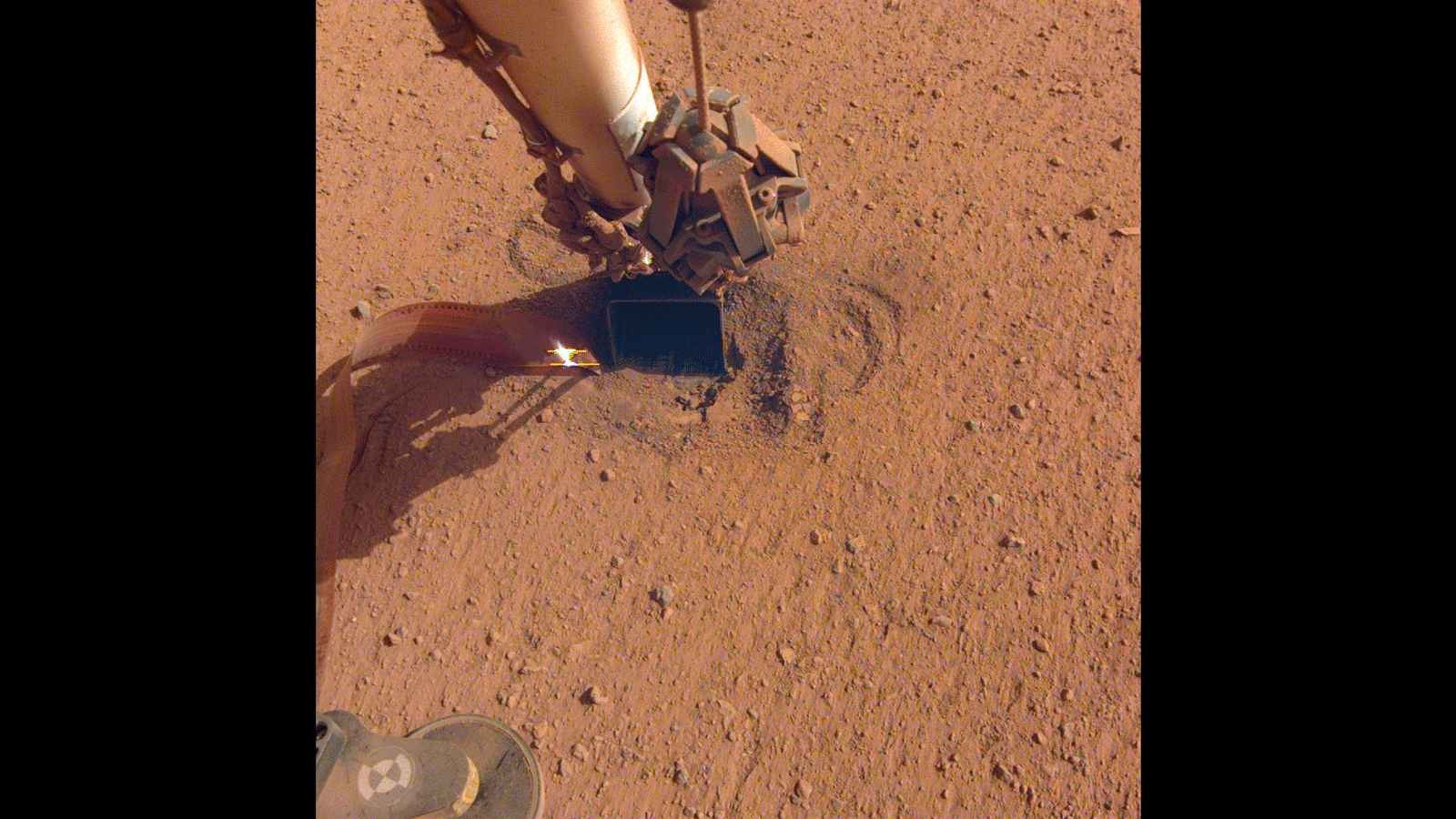 months to do this, don’t expect any hammering to resume until early in 2021. The mole is a 16 inch long assembly and at a 30 degree angle in the ground. My estimate of its depth is 14 inches plus a few inches of dirt above. So my depth estimate is about 17 inches. Scientists hope to get at least 10 feet down for decent science results measuring heat flow through the Martian soil.
months to do this, don’t expect any hammering to resume until early in 2021. The mole is a 16 inch long assembly and at a 30 degree angle in the ground. My estimate of its depth is 14 inches plus a few inches of dirt above. So my depth estimate is about 17 inches. Scientists hope to get at least 10 feet down for decent science results measuring heat flow through the Martian soil.
Marcus House, one of my favorite YouTubers, did a great summary on the development of Starship (only the first 7 minutes of video are StarShip related). It is amazing how far SpaceX has come in just 1 1/2 years. Starting with the StarHopper, then to MK1, SN1, SN3, SN4, SN5 & SN6 hops, explosions and tank ruptures. You get a good view of Boca Chica development area in Texas. I’m always amazed that SpaceX performs this development under the watchful eye of video cameras and drones. We never get to see what Blue Origin is up to. Hopefully, we can add a 15 km flight soon. It could occur before the end of 2020. Remember how long SLS has been under development, roots go back to 2008. Starship will lift about twice as much as the first version of SLS. 150 mt vs 70 mt.
Serial Number 8 (SN8) belly flop – The latest StarShip test article is SN8. This is the first full sized StarShip with a nose cone and 3 Raptor engines. After performing static fires of the engines, SpaceX plans to have SN8 climb to 15 km (50,000 ft), cut its engines and do a free fall back to Earth. During the last few seconds, the engines will relight, and the vehicle will flip over and land on its tail. Here is a simulation of what it might look like. You have to realize this is a stainless steel vehicle 9 m in diameter (29 ft). In its final configuration, StarShip will have 6 Raptor engines, 3 optimized for sea-level and 3 optimized for vacuum. The StarShip will sit on the Super Heavy first stage which will have 28 Raptor engines. Because the entire Starship will be reusable, Elon Musk says he will be able to launch it for $2 million or the cost of the fuel. StarShip is rated to put 150 mt into LEO. This is about as much as the Saturn 5 rocket or about 20 mt more than the third iteration of the SLS rocket.
Starlink beta test – SpaceX is beginning a beta test of its Internet from space Starlink service. Cost is $99/month with a $500 initial investment. The service promises of speeds of 50-150 Mbps and latency from 20-40 ms. By Summer of 2021, latency should improve to 16-19 ms. The $500 gets you a phased-array user terminal with a mounting and a wi-fi router.
During the meeting I forgot to mention the Osiris-Rex sample attempt at the asteroid Bennu. Here are my notes from the “tag” sampling event. On October 20, 2020, Osiris-Rex actually touched the asteroid for about 6 seconds and might have sunk its sample device as much as a foot into the regolith. Here is a short 1 minute video of event with great music, jubilation in the control room, Dante Laureta the chief scientist of the mission and the tag event in slow motion with liberated rocks flying everywhere. The tag seemed to go well, it had to be much more accurate because Bennu (500 meter diameter) was more rocky than anticipated. Originally a 50 meter accuracy goal was anticipated but the Nightingale safe-area was only 16 meters (52 ft) in diameter. New software was developed so that Osiris-Rex could use pictures of features visually and then use awareness of those features to navigate its touchdown. Actual accuracy for the touchdown was stated to be within 1 meter of the target goal. Quite an amazing feat! The goal for the sample was at least 60 grams (2 oz) but the sample container can hold up to 2 kg. Based on the fact that the container had difficulty closing, scientists think they have at least 400 grams of sample. The original plan was to spin the spacecraft to see how much more the sample container weighed after sampling. But with material escaping from it, scientists decided to cancel the spin operation. Almost too successful in sample that the lid didn’t close and pieces floating away With the air release at touch down, Scott Manley described the tag as giving the asteroid a “raspberry”.
This will be largest asteroid sample ever obtained. Japan’s Hayabusa 1 sampled asteroid Itokana for 60 mg (that is milligrams, 1000 mg = 1 g). The currently returning Hayabusa 2 is believed to have a 100 mg (.1 g) sample from Ryugu. Russia performed 3 sample returns from moon, Luna 16 got 101g, Luna 20 got 55g and Luna 24 had the largest sample at 170g. For reference 28g equals 1oz. Two raisins weigh about 1 gram. Of the returning Bennu sample 4% will go to Canada, .5% to Japan as a trade for some Ryugu material. Ryugu and Bennu both have very similar diamond shape even though Ryugu is twice the diameter at 1000 m and has no water. Bennu has a lot of water. The tension during the descent of Osiris-Rex reminded me of the “7 minutes of terror” from the Curiosity rover landing on Mars. Osiris-Rex will head back toward earth in March 2021 and arrive back at earth on Sept 24, 2023, landing in the Utah desert on parachutes.
Osiris-Rex is the 3rd of NASA’s “New Frontiers”, medium class missions. New Horizons and Juno being the first two. It cost $1.16 billion. At Bennu, there was a 18-minute signal delay due to the 200 million miles distance from Earth. The “tag” event was completely automated. Bennu is the smallest object ever orbited. Osiris-Rex orbited only 1mi high. Gravity at Bennu is only 6 micro g’s. My 300# body mass would only weigh ¼ of an oz on Bennu. Hum, maybe Bennu is a great place to go for a weight reduction program.
The sample from Bennu is extreme precious because this asteroid is of the rare carbonaceous type. It should give clues to the origin of the solar system because its rocks have never been crushed or baked or mixed. Knowing Bennu’s makeup will help on future asteroid diversion plans too. Bennu is a potentially hazardous asteroid (PHA) because its orbit crosses the Earth’s. NASA has calculated a 1 in 2700 chance of a collision in the 2100s with Bennu.
In sample device development, NASA and JAXA have selected PlanetVac (partially supported by Planetary Society grants) to send a vacuum sample collection system to the moon in 2023 as part of NASA’s CLIPS program and Phobos with Japan’s 2024 MMX (Mars Moons eXploration mission) probe. Check out the great picture of Phobos on the site. Here is the PlanetVac in operation. Samples will be return to earth in both missions.
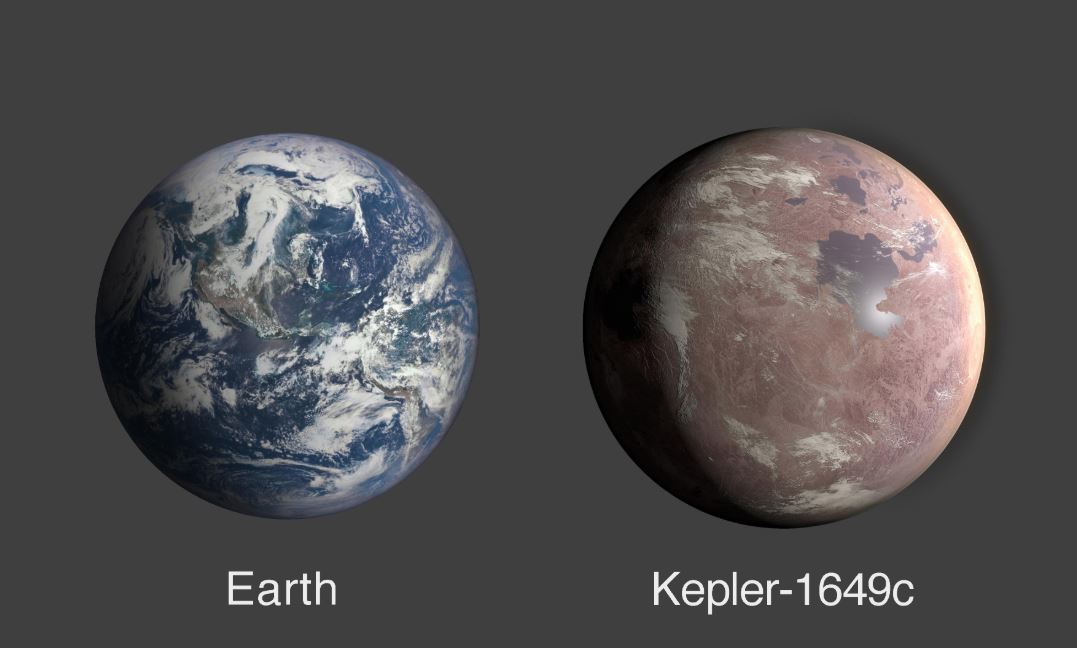
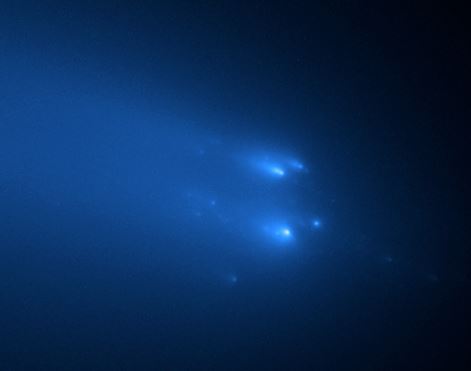
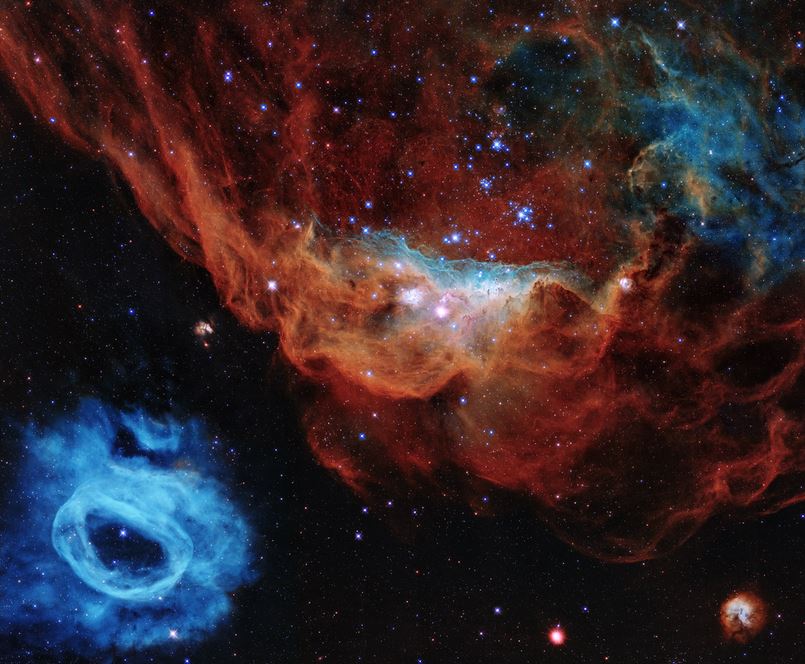
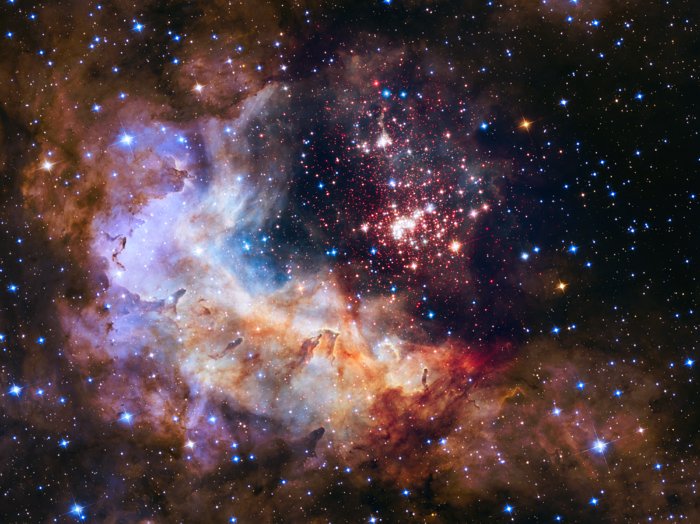

Recent Comments